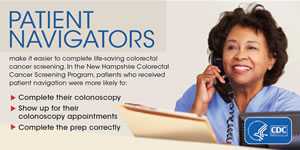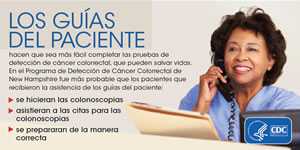New Hampshire Colorectal Cancer Screening Program Patient Navigation Model
Colorectal cancer is the second most common cause of cancer deaths in the United States among cancers that affect both men and women, although it is preventable. Screening and surveillance are effective ways to prevent colorectal cancer and find it early, but screening rates remain relatively low, especially among low-income, uninsured, and underinsured people.
The New Hampshire Colorectal Cancer Screening Program (NHCRCSP) patient navigation model has been highly effective in increasing the completion and quality of colonoscopy screening among these groups. The results of a comparison group study showed that NHCRCSP-navigated patients were 11 times more likely to complete colonoscopy than non-navigated patients. Given its success, CDC and NHCRCSP developed a manual to help others replicate the model.
This manual provides specific information and tools to replicate the NHCRCSP patient navigation model. We provide detailed information on implementing a model that improves completion of colonoscopy and follow-up, increases patients’ knowledge about their tests and results, and improves overall screening quality and patient satisfaction.
Intended Audiences
Any organization that conducts colorectal cancer screening or administers a colonoscopy program may benefit from implementing this intervention. Organizations could include health systems, endoscopy centers, primary care practices (including Federally Qualified Health Centers), universities, state or local health departments, and grantee programs. This manual also may be useful for health care providers, pharmacy staff, and other community partners to clarify their roles in the intervention and how it benefits their patients.
Shareable Graphics
You can copy and paste the code to embed these shareable graphics in your Web site, social network profile, or blog.
- Page last reviewed: February 6, 2017
- Page last updated: February 6, 2017
- Content source:


 ShareCompartir
ShareCompartir


